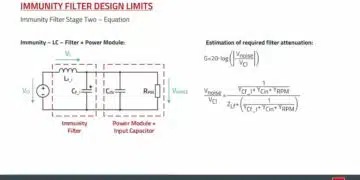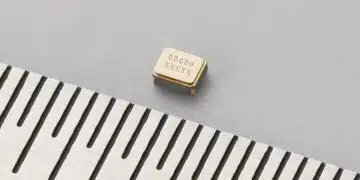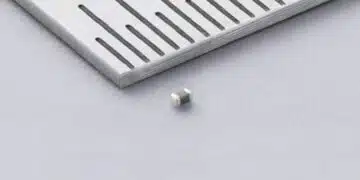This presentation from Würth Elektronik by Timur Uludag delves into overvoltage protection for safe operation-transient protection for non-isolated DC/DC Power Modules in a practical case study of advanced input transient protection for 24V non-isolated DC/DC power module.
Key Takeaways
- This article discusses advanced overvoltage protection for non-isolated DC/DC Power Module applications.
- Unmitigated voltage transients can damage sensitive components, causing operational downtime.
- Implementing a two-stage protection system with a TVS diode and passive LC filter enhances reliability.
- Designing robust filters requires careful selection of components and consideration of temperature effects.
- Merging immunity and emission filters can optimize space, but thorough validation is essential for effectiveness.
Introduction
Industrial systems utilizing non-isolated DC/DC power modules are increasingly exposed to disruptive voltage transients that can induce catastrophic failures and operational downtime.
Effective overvoltage and transient suppression is crucial for ensuring reliability and compliance with EMC regulations. This white paper explores advanced filter concepts for transient protection, focusing on a two-stage approach suited to typical 24V bus applications found in industrial environments.
1. Understanding Voltage Transients and Their Effects
1.1 What Are Voltage Transients?
Transients are short-term deviations in voltage which exceed the nominal operational range of a system. In a regulated 24V bus, any spike above the design limit is termed a transient, often triggered by external events (e.g., lightning) or internally by switching loads.
1.2 Impact of Transients in Industrial Applications
Unmitigated transients can:
- Destroy sensitive input stages of DC/DC modules
- Propagate across the system causing multi-point damage
- Lead to costly downtimes and increased maintenance
| Source Type | Example | Effect |
|---|---|---|
| External | Lightning strike entering mains | High-energy system-wide surge |
| Internal | Motor load dump, frequency converter cross-coupling | Localized voltage spikes |
2. Core Protection Concepts for 24V DC/DC Power Modules
2.1 Structure of the Protection System
The recommended input protection system relies on a two-stage configuration:
- TVS Diode Stage (Immunity Filter): Rapidly clamps high overvoltages during surge events.
- Passive LC Filter Stage: Attenuates residual voltages above the safe operating threshold of the module.
2.2 Why Two Stages?
Relying solely on a TVS diode is insufficient due to its temperature dependence and finite clamping capability. The LC filter manages transients not fully suppressed by the TVS, ensuring complete system protection.
3. Designing a Robust Input Filter: Parameters and Equations
3.1 Key Parameters for TVS Selection
Select a TVS diode using:
- System supply voltage (VDC)
- Breakdown voltage (VBR)
- Peak pulse current and power dissipation
- Maximum clamping voltage at given peak current (VClamp,max)
A properly chosen TVS diode has VBR above the maximum operating bus voltage but below the absolute maximum rating of connected modules.
3.2 Temperature Effects on TVS Diode Behavior
Clamping voltage rises with temperature, requiring de-rating: VClamp,max(T) = VClamp,25°C × (1 + α × ΔT) Where α is the temperature coefficient, and ΔT is temperature rise from 25°C.
For example, a laboratory value of 48.4V at 25°C could increase to 49.8V at 55°C (approx. 3% rise).
3.3 LC Filter Dimensioning and Trade-offs
The LC filter must ensure that VPM,max (absolute max allowable input voltage from module datasheet) is not exceeded.
Required attenuation (in decibels) is found by: AdB = 20 × log₁₀(VClamp,max / VPM,max)
For a real world example:
- VDC = 30V (max on 24V bus)
- TVS VClamp,max = 49.8V (at 55°C)
- Module VPM,max = 44V
- Calculated attenuation ≈ 1.08 dB
| Inductor (μH) | Capacitor (μF) | Description |
|---|---|---|
| 12 | 280 | Typical configuration @ 55°C |
| 20 | 110 | If higher inductor used, lower capacitor value possible |
| 5 | 600 | If lower inductor used, larger capacitor needed |
4. Advanced Considerations and Practical Tips
4.1 The Consequence of Temperature Neglect
If temperature effect on VClamp,max is ignored, the chosen capacitor may be undervalued by >20%, leading to inadequate attenuation and potential system failure.
4.2 Merging Immunity and Emission Filters
It is possible to combine the immunity (protection) and emission (EMC) filter into a single LC structure, but this requires thorough validation under real measurement conditions to balance both functions effectively.
4.3 Data Sheet Use and Practical Selection
Always refer to module and TVS manufacturer datasheets for:
- Input capacitance (CIN)
- Clamping voltages across temperature
- Recommended filter layouts
4.4 Special Applications: Wide Temperature and Input Voltage Ranges
For extended application requirements (e.g., -40°C to 85°C, 18–36V buses), consult the supplier’s tools or application notes for suitable TVS and filters.
Conclusion
Robust transient protection in 24V DC/DC power module applications requires a two-stage input filter approach: a correctly specified TVS diode for high-speed surge suppression and a dimensioned LC filter for residual transient attenuation.
Temperature, worst-case input scenarios, and careful reference to datasheets and application notes are vital for safe, EMC-compliant system design. For combined immunity and emission filtering or extended application conditions, seek further application guidance and empirically validate filter designs.
FAQ: Overvoltage and Transient Protection for Non-Isolated DC/DC Power Modules
Voltage transients are short-term deviations from the nominal value of a bus voltage, often caused by lightning strikes or internal switching events such as motor operations. These spikes can exceed defined tolerance ranges and lead to destructive effects within electrical systems.
ithout adequate input filtering, destructive transients can damage the module’s input stage and propagate through the entire industrial system, causing downtime and costly repairs.
The first stage uses a TVS diode to clamp high-energy spikes. The second stage employs a passive LC filter to attenuate remaining voltages and ensure they do not exceed the maximum ratings of DC/DC modules.
TVS diodes are temperature-dependent and have limited clamping capabilities. High-temperature environments can increase clamping voltage, making a supplementary LC filter necessary for comprehensive protection.
Choosing capacitor and inductor values without considering temperature or worst-case transient voltages leads to insufficient damping. This can result in permanent damage to the power module and further propagation of transients.
It is possible but requires careful measurement and validation to ensure both EMC and transient protection. Exact values depend on system configuration and target compliance standards.
How-to: Design a Two-Stage Input Filter for Transient Protection
- Define Your Bus Specifications
Identify the nominal and maximum DC bus voltage (e.g. 24 V nominal, 30 V max for industrial buses).
- Select an Appropriate TVS Diode
Choose a TVS diode with:
– Breakdown voltage (VBR) higher than the maximum operating voltage but lower than the absolute max rating.
– Adequate peak current and power dissipation for your application.
– Maximum clamping voltage at relevant temperature (e.g. consider 55°C instead of only 25°C). - Calculate Required LC Filter Attenuation
Use attenuation formula:
Attenuation (dB) = 20 × log₁₀(VClamp,max / VModule,max)
Example: If VClamp,max = 49.8 V (at 55°C) and VModule,max = 44 V, attenuation ≈ 1.08 dB. - Determine Filter Component Values
Based on attenuation, select a suitable combination of inductor and capacitor, such as:
– 12 μH inductor and 280 μF capacitor for typical industrial setups.
Adjust these based on available components and temperature coefficients. - Validate With Real World Conditions
Check the filter’s behavior under full operating temperature range and worst-case transients. Use manufacturer datasheets and simulation if available.
- Optionally Merge Immunity and Emission Filters
For space or cost optimization, consider merging the stages, but test thoroughly to maintain both EMC and transient suppression.




























